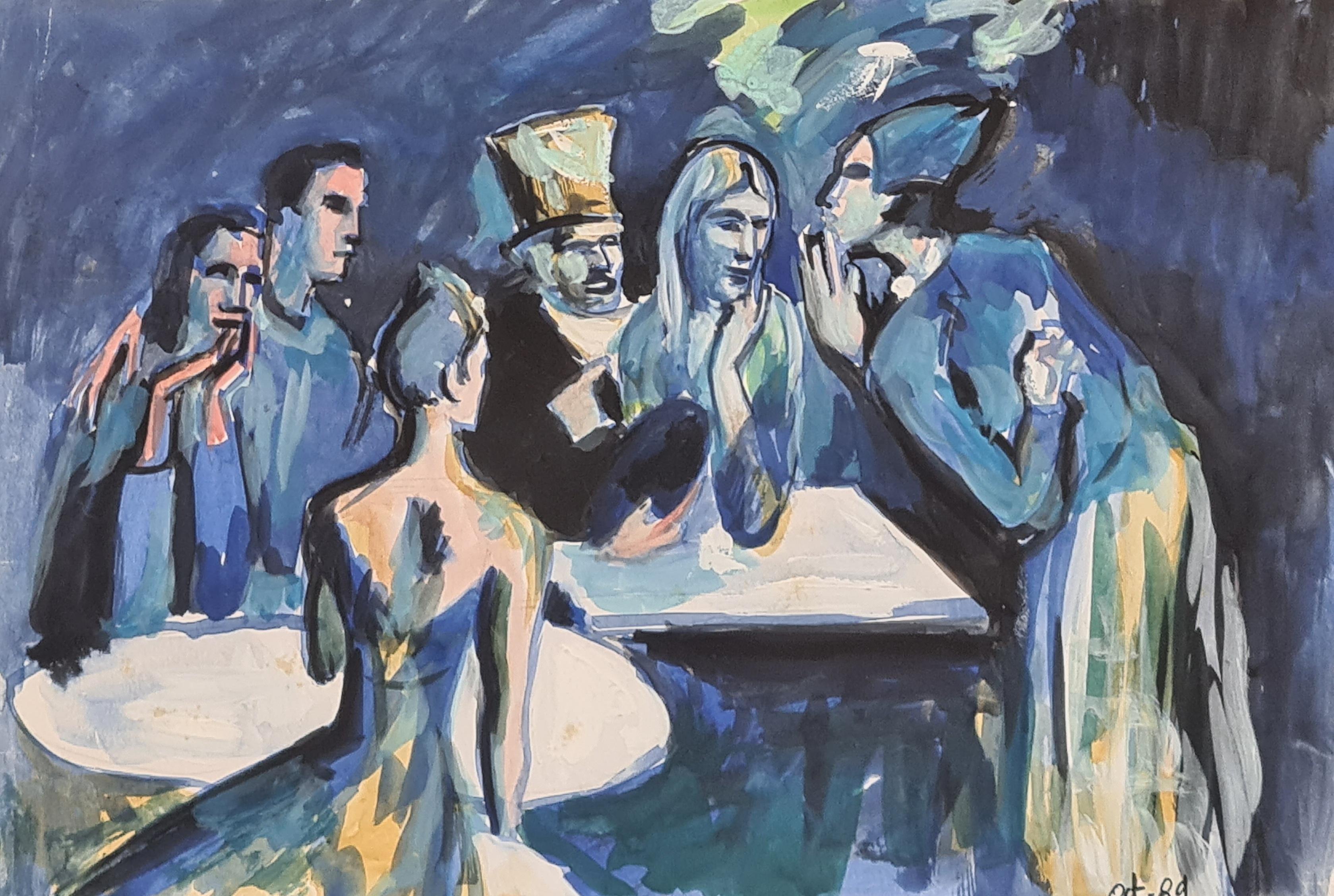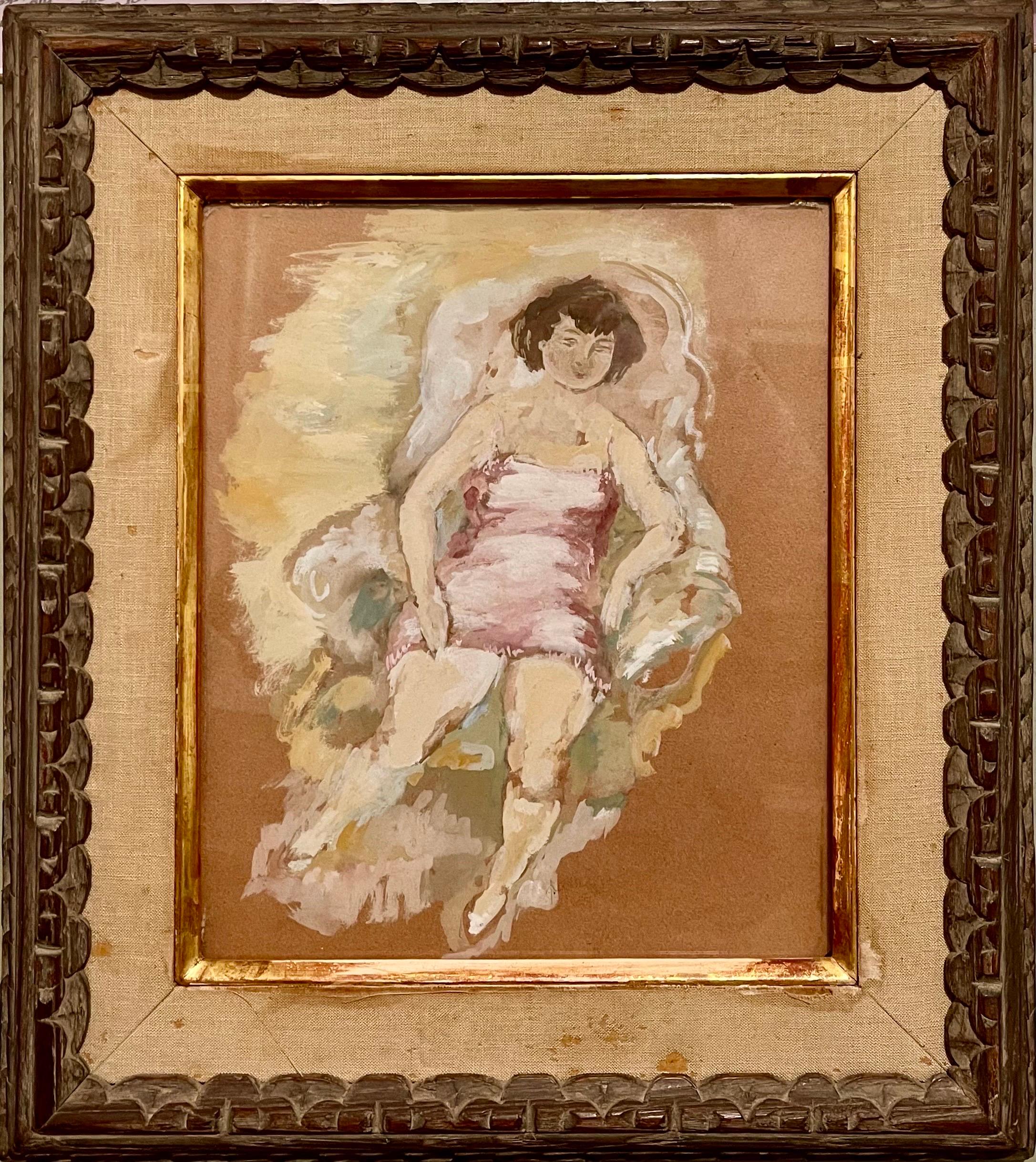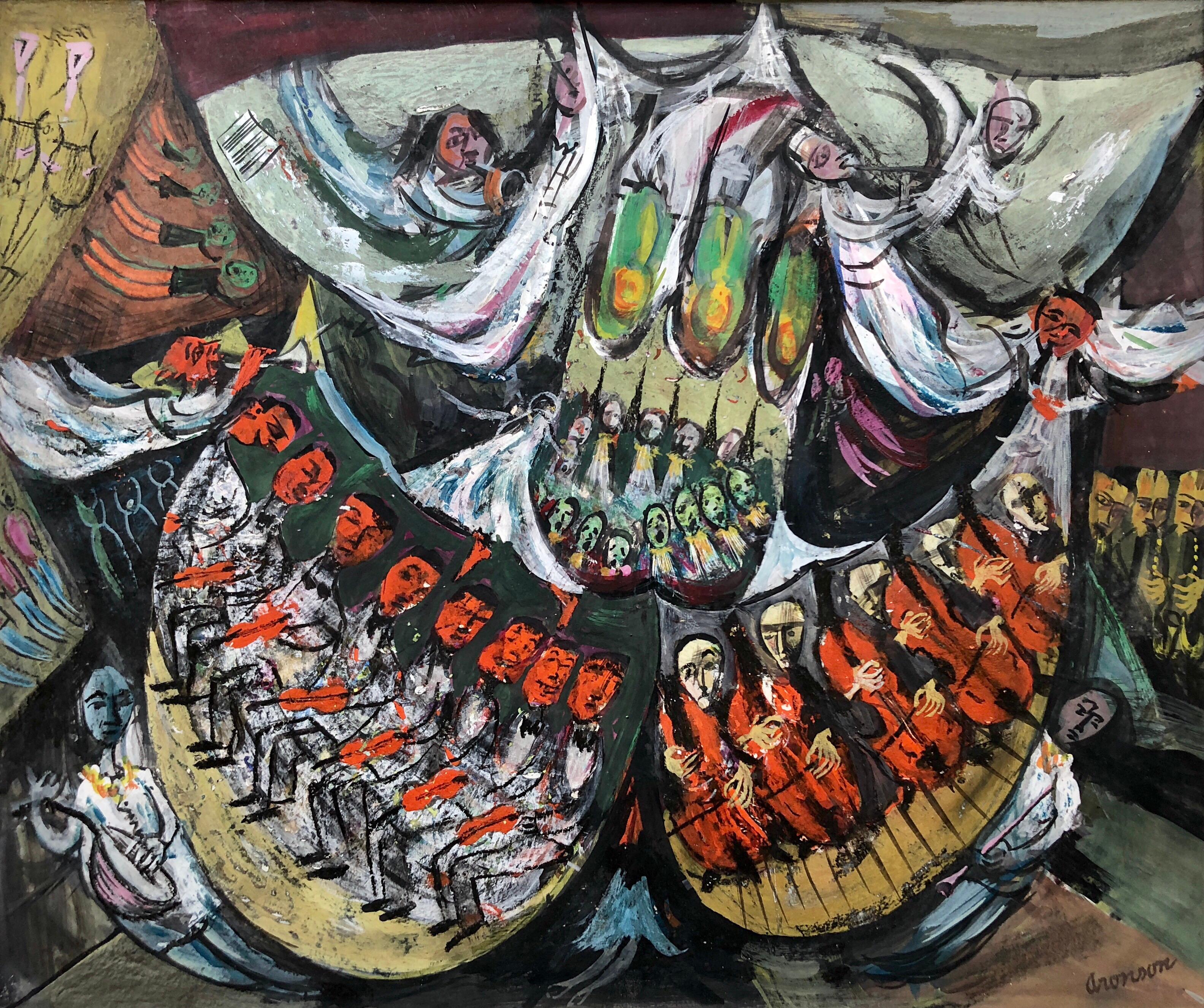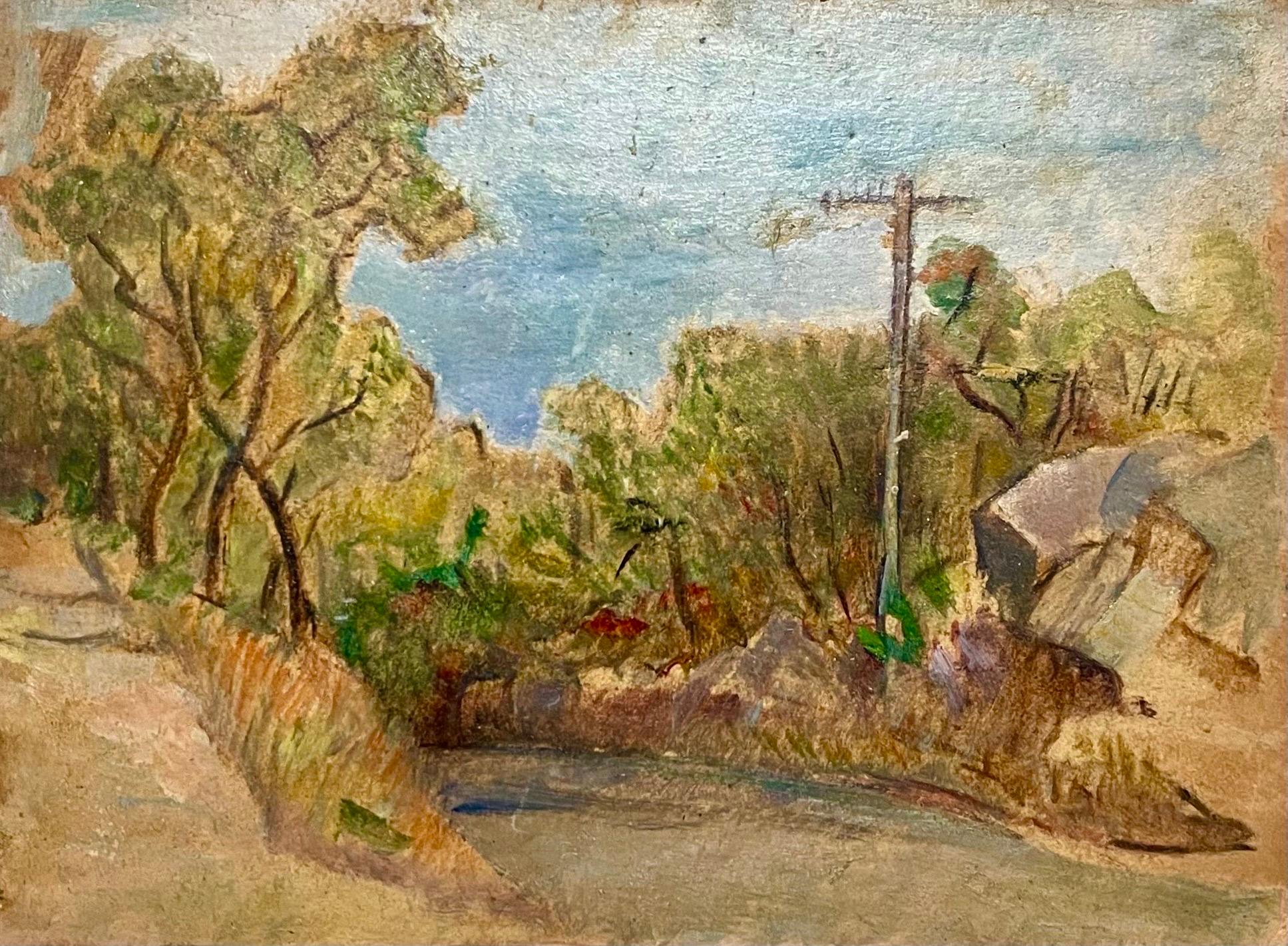Items Similar to Story Illustration
Want more images or videos?
Request additional images or videos from the seller
1 of 6
Orson LowellStory Illustration
About the Item
Medium: Sepia Gouache on Board
Dimensions: 25.50" x 16.50"
Signature: Signed Lower Right
Story Illustration, Two Victorian women, man reading letter
Lowell moved from Chicago to New York in 1893. Known for the richness of his work in pen and ink, he drew, in 1898, fifty illustrations for The Choir Invisible. By 1907, he was employed at Life magazine, at that time a humor publication competing with Judge and Punch.
- Creator:Orson Lowell (1871 - 1956)
- Dimensions:Height: 25.5 in (64.77 cm)Width: 16.5 in (41.91 cm)
- Medium:
- Period:
- Condition:
- Gallery Location:Fort Washington, PA
- Reference Number:1stDibs: LU38431557963
About the Seller
5.0
Recognized Seller
These prestigious sellers are industry leaders and represent the highest echelon for item quality and design.
Gold Seller
These expertly vetted sellers are highly rated and consistently exceed customer expectations.
Established in 1995
1stDibs seller since 2016
107 sales on 1stDibs
Typical response time: 5 hours
- ShippingRetrieving quote...Ships From: Fort Washington, PA
- Return PolicyA return for this item may be initiated within 14 days of delivery.
More From This SellerView All
- Group of Four: Baseball Themed IllustrationsLocated in Fort Washington, PAMedium: Watercolor, Gouache & Charcoal on Board Date: 1950s Dimensions: Various Sizes Signature: Unsigned Contact for exact dimensions. AMERICAN ARTIST (20th Century) Group of four...Category
1950s Figurative Paintings
MaterialsCharcoal, Board, Gouache, Watercolor
- Colonial Men ConversingBy Simon GrecoLocated in Fort Washington, PAMedium: Gouache on Board Dimensions: 12.00" x 16.00" Signature: Signed Lower LeftCategory
20th Century Figurative Paintings
MaterialsBoard, Gouache
- Dancing Couple at the Ball, Theatre Magazine CoverBy Clara PeckLocated in Fort Washington, PAMedium: Gouache watercolor painting on artist board Signature: Signed Lower Left Size: 18" x 14"Category
20th Century Figurative Paintings
MaterialsGouache, Board, Watercolor
- Frolicking Harlequin and Ballerina, Theatre Magazine CoverBy Clara PeckLocated in Fort Washington, PADate: 1921 Medium: Gouache and Watercolor on Artist Board Dimensions: 17.00" x 14.00" Signature: Signed Lower Center November 1921 Theatre Magazine CoverCategory
1920s Figurative Paintings
MaterialsGouache, Watercolor, Board
- The First American Law SchoolBy Simon GrecoLocated in Fort Washington, PADate: 1948 Medium: Gouache on Board Dimensions: 12.00" x 16.00" 1948 pattern for Liberty.Category
1940s Figurative Paintings
MaterialsBoard, Gouache
- "Horses, Honor, and Women" Book CoverLocated in Fort Washington, PAMedium: Gouache on Board Dimensions: 14" x 8.5" Date: 1972 Signature: Initialed TH Paperback Book Cover American Artist (20th Century)Category
1970s Figurative Paintings
MaterialsGouache, Board
You May Also Like
- The Circus Troupe and Saltimbanque after Pablo PicassoBy (after) Pablo PicassoLocated in Cotignac, FRLate 20th Century gouache work on card of a group of circus performers around a table after Pablo Picasso. The work is dated bottom right. A charming watercolour and gouache of a tr...Category
Late 20th Century Modern Figurative Paintings
MaterialsWatercolor, Gouache, Cardboard
- Small InteriorsLocated in Aberdeen Dyce, GBGala Hills (b. 2001) is an artist from Devon and recent Ruskin School of Art graduate. Her work is steeped in domesticity, celebrating mundane rituals and drawing attention to the im...Category
21st Century and Contemporary Other Art Style Figurative Paintings
MaterialsEmulsion, Pigment, Board, Gouache
- Red Figure Holding a Heart - Irish ArtLocated in London, GBThis original work is hand signed in ink by the artist at the lower right corner "Rakoczi". Condition: Very good condition. A few cuts in the edges of the board (possibly from forme...Category
20th Century Figurative Paintings
MaterialsInk, Board, Gouache, Oil
- Gouache Painting Jules Pascin Hand Signed Woman in Boudoir German ExpressionismBy Jules PascinLocated in Surfside, FLGenre: German Expressionist Subject: Woman Medium: gouache paint Surface: Paper board This is hand signed lower right. Framed it measures 17.25 X 15.5, sheet 12 X 10 This came from a Jewish estate. there was no additional paperwork or provenance. Julius Mordecai Pincas (March 31, 1885 – June 5, 1930), known as Pascin Jules...Category
Early 20th Century Expressionist Figurative Paintings
MaterialsPaper, Cardboard, Gouache
- Modernist Orchestra Musical Gouache Painting Boston ExpressionistBy David AronsonLocated in Surfside, FLVery vibrant, dynamic orchestra scene reminiscent of the work of Mopp (Max Oppenheim) David Aronson, (1923-2015) son of a rabbi, was born in Lithuania in 1923 and immigrated to America at the age of five. He settled in Boston, Massachusetts where he studied at the school of the Museum of Fine Arts under Karl Zerbe, a German painter well known in the early 1900s. Aronson later taught at the school of the Museum of Fine Arts for fourteen years and founded the School of Fine Art at Boston University where he is today a professor emeritus. An internationally renowned sculptor & painter, Aronson has won acclaim for his interpretation of themes from the Hebrew Talmud and Kabala. His best known works include bronze castings, encaustic paintings, and pastels. His work is included in many important public and private collections, and has been shown in several museum retrospectives around the country. He is considered to be one of the most important 20th century American artists. At twenty-two David Aronson had his first one-man show at New York's Niveau Gallery. The next year, six of his Christological paintings were included in the Fourteen Americans exhibition at Manhattan's Museum of Modern Art where Aronson’s work was included alongside abstract expressionists Arshile Gorky, Robert Motherwell and Isamu Noguchi. In the 1950s, Aronson turned more toward his Jewish heritage for the inspiration for his art. Folklore as well as Kabalistic and other transcendental writings influenced his work greatly. The Golem (a legendary figure, brought to life by the Maharal of Prague out of clay to protect the Jewish community during times of persecution) and the Dybbuk (an evil spirit that lodges itself in the soul of a living person until exorcised) frequently appear in his work. In the sixties, Aronson turned to sculpture. His work during this period is best exemplified by a magnificent 8’ x 4’ bronze door which now stands at the entrance to Frank Lloyd Wright's Johnson Foundation Conference Center for the Arts in Racine, Wisconsin. In the seventies and eighties, Aronson continued his work in pastel drawings, paintings, and sculptures, often exploring religion and the frailties of man's nature. During this time, in addition to a traveling retrospective exhibition and many one-man shows in New York, Los Angeles, Chicago, and Boston at the Pucker-Safrai Gallery on Newbury Street, Aronson won many awards and became a member of the National Academy of Design in New York. Two years ago he retired from teaching to work full-time in his studio in Sudbury, Massachusetts. included in the catalog Contemporary Religious Imagery in American Art Catalog for an exhibition held at the Ringling Museum of Art, March 1-31, 1974. Artists represented: David Aronson, Leonard Baskin, Max Beckmann, Hyman Bloom, Fernando Botero, Paul Cadmus, Marvin Cherney, Arthur G. Dove, Philip Evergood, Adolph Gottlieb, Jonah Kinigstein, Rico Lebrun, Jack Levine, Louise Nevelson, Barnett Newman, Abraham Rattner, Ben Shahn, Mark Tobey, Max Weber, William Zorach and others. Selected Awards 1990, Certificate of Merit, National Academy of Design 1976, Purchase Prize, National Academy of Design 1976, Joseph Isidore Gold Medal, National Academy of Design 1976, Purchase Prize in Drawing, Albrecht Art Museum 1975, Isaac N. Maynard Prize for Painting, National Academy of Design 1973, Samuel F. B. Morse Gold Medal, National Academy of Design 1967, Purchase Prize, National Academy of Fine Arts 1967, Adolph and Clara Obrig Prize, National Academy of Design 1963, Gold Medal, Art Directors Club of Philadelphia 1961, 62, 63, Purchase Prize, National Institute of Arts and Letters 1960, John Siimon Guggenheim Fellowship 1958, Grant in Art, National Institute of Arts and Letters 1954, First Prize, Tupperware Annual Art Fund Award 1954, Grand Prize, Third Annual Boston Arts Festival 1953, Second Prize, Second Annual Boston Arts Festival 1952, Grand Prize, First Annual Boston Arts Festival 1946, Traveling Fellowship, School of the Museum of Fine Arts 1946, Purchase Prize, Virginia Museum of Fine Arts 1944, First Popular Prize, Institute of Contemporary Art 1944, First Judge's Prize, Institute of Contemporary Art Selected Public Collections Art Institute of Chicago Virginia Museum of Fine Arts Bryn Mawr College Brandeis University Tupperware Museum, Orlando, Florida DeCordova Museum Museum of Modern Art Print Collection, New York Atlanta University Atlanta Art...Category
20th Century Expressionist Figurative Paintings
MaterialsGouache, Board
- Simka Simkhovitch WPA Artist Oil Painting Gouache American Modernist PowerlineBy Simka SimkhovitchLocated in Surfside, FLSimka Simkhovitch (Russian/American 1893 - 1949) This came with a small grouping from the artist's family, some were hand signed some were not. These were studies for larger paintings. Simka Simkhovitch (Симха Файбусович Симхович) (aka Simka Faibusovich Simkhovich) (Novozybkov, Russia May 21, 1885 O.S./June 2, 1885 N.S.—Greenwich, Connecticut February 25, 1949) was a Ukrainian-Russian Jewish artist and immigrant to the United States. He painted theater scenery in his early career and then had several showings in galleries in New York City. Winning Works Progress Administration (WPA) commissions in the 1930s, he completed murals for the post offices in Jackson, Mississippi and Beaufort, North Carolina. His works are in the permanent collections of the Dallas Museum of Art, the National Museum of American Art and the Whitney Museum of American Art. Born outside Kyiv (Petrograd Ukraine) into a Jewish family who owned a small department store. During a severe case of measles when he was seven, Simcha Simchovitch sketched the views outside his window and decided to become an artist, over his father's objections. Beginning in 1905, he studied at the Grekov Odessa Art School and upon completion of his studies in 1911 received a recommendation to be admitted to the Imperial Academy of Arts. Though he enrolled to begin classes in architecture, painting, and sculpture at the Imperial Academy, he was dropped from the school roster in December because of the quota on the number of Jewish students and drafted into the army. Simchovitch served as a private in the 175th Infantry Regiment Baturyn [ru] until his demobilization in 1912. Re-enrolling in the Imperial Academy, he audited classes. Simka Simkhovitch exhibited paintings and sculptures in 1918 as part of an exhibition of Jewish artists and in 1919 placed 1st in the competition "The Great Russian Revolution" with a painting called "Russian Revolution" which was hung in the State Museum of Revolution. In 1922, Simkha Simkhovitch exhibited at the International Book Fair in Florence (Italian: Fiera Internazionale del Libro di Firenze). In 1924, Simkhovitch came to the United States to make illustrations for Soviet textbooks and decided to immigrate instead. Initially he supported himself by doing commercial art and a few portrait commissions. In 1927, he was hired to paint a screen for a scene in the play "The Command to Love" by Fritz Gottwald and Rudolph Lothar which was playing at the Longacre Theatre on Broadway. Art dealers began clamoring for the screen and Simkhovitch began a career as a screen painter for the theater. Catching the attention of the screenwriter, Ernest Pascal, he worked as an illustrator for Pascal, who then introduced him to gallery owner, Marie Sterner. Simkhovitch's works appeared at the Marie Sterner Gallery beginning with a 1927 exhibit and were repeated the following year. Simkhovitch had an exhibit in 1929 at Sterner's on circus paintings. In 1931, he held a showing of works at the Helen Hackett Gallery, in New York City and later that same year he was one of the featured artists of a special exhibit in San Francisco at the California Palace of the Legion of Honor in Lincoln Park. The exhibit was coordinated by Marie Sterner and included four watercolors, including one titled "Nudes". He is of the generation of Russian Soviet artists such as Isaac Pailes, Serge Charchoune, Marc Chagall, Chana Orloff, Isaac Ilyich Levitan, and Ossip Zadkine. In 1936, Simkhovitch was selected to complete the mural for the WPA Post office project in Jackson, Mississippi. The mural was hung in the post office and courthouse in 1938 depicted a plantation theme. Painted on the wall behind the judge’s bench, “Pursuits of Life in Mississippi”, a depiction of black workers engaged in manual labor amid scenes of white professionals and socialites, was eventually covered over in later years during renovations due to its stereotypical African American imagery. Simka painted what he thought was typical of Jackson. His impression of pre-civil rights Mississippi was evidently Greek Revival column houses, weeping willow trees, working class families, and the oppression of African Americans. He painted African American men picking cotton, while a white man took account of the harvest and a white judge advised a white family, calling it Pursuits of Life in Mississippi. Though clearly endorsed by the government and initially generally well-received, the mural soon raised concerns with locals as the climate toward racial segregation began to change. The main concern was whether depictions that show African Americans in subjugated societal roles should be featured in a courtroom. The following year, his painting "Holiday" won praise at an exhibition in Lincoln, Nebraska. In 1940, Simkhovitch's second WPA post office project was completed when four murals, "The Cape Lookout Lighthouse and the Orville W. Mail Boat", "The Wreck of the Crissie Wright", "Sand Ponies" and "Canada Geese" were installed in Beaufort, North Carolina. The works were commissioned in 1938 and did not generate the controversy that the Jackson mural had. The main mural is "The Wreck of the Crissie Wright" and depicts a shipwreck which had occurred in Beaufort in 1866. "The Cape Lookout Lighthouse and the Orville W. Mail Boat" depicted the lighthouse built in 1859 and the mail boat that was running mail during the time which Simkhovitch was there. The boat ran mail for the area until 1957. "Sand Ponies" shows the wild horses common to the North Carolina barrier islands and "Canada Geese" showed the importance of hunting and fishing in the area. All four murals were restored in the 1990s by Elisabeth Speight, daughter of two other WPA muralists, Francis Speight...Category
1930s American Modern Landscape Paintings
MaterialsGouache, Oil, Board
Recently Viewed
View AllMore Ways To Browse
Two Story
Antique Story
Antique Stories
Illustration Chicago
Victorian Women
Magazine Story Illustration
Man Reading
Women Reading
Antique Life Magazines
Victorian Illustration
Letter Board
Chicago 1907
Man Reading Painting
Victorian Antique Illustrations
Letter Man Painting
Paintings Of Women Reading
Invisible Man
Punch Board





